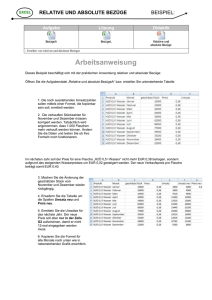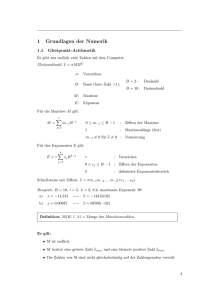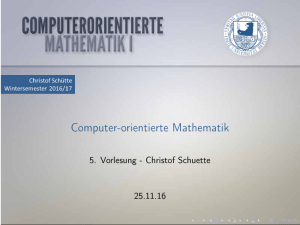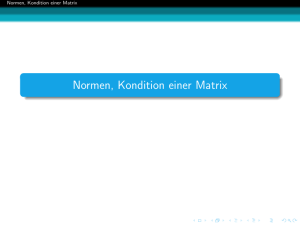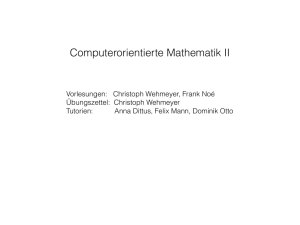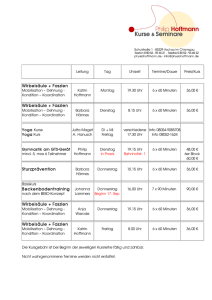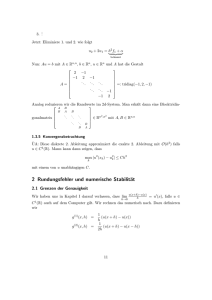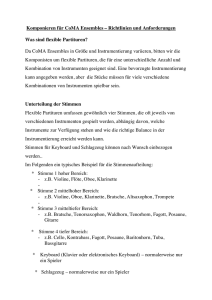Rundungsfehler und Gleitkommaarithmetik Vorlesung vom 6.11.15
Werbung
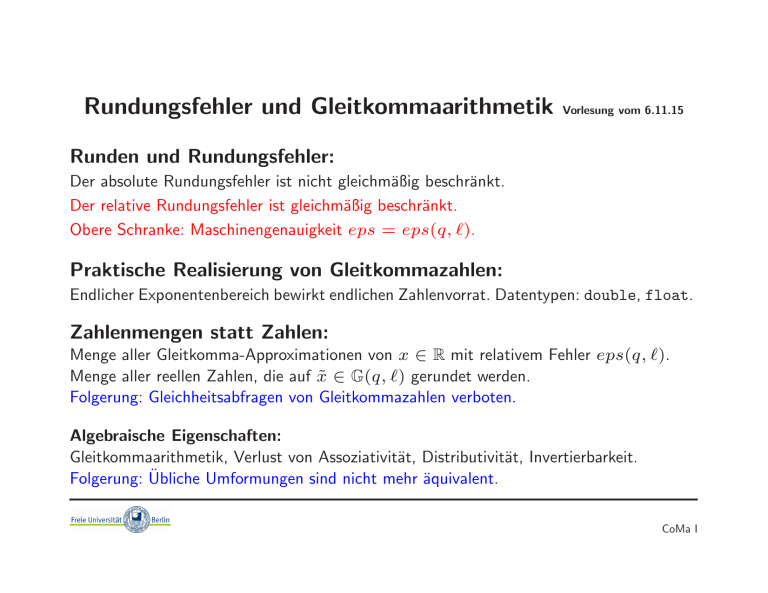
Rundungsfehler und Gleitkommaarithmetik
Vorlesung vom 6.11.15
Runden und Rundungsfehler:
Der absolute Rundungsfehler ist nicht gleichmäßig beschränkt.
Der relative Rundungsfehler ist gleichmäßig beschränkt.
Obere Schranke: Maschinengenauigkeit eps = eps(q, ℓ).
Praktische Realisierung von Gleitkommazahlen:
Endlicher Exponentenbereich bewirkt endlichen Zahlenvorrat. Datentypen: double, float.
Zahlenmengen statt Zahlen:
Menge aller Gleitkomma-Approximationen von x ∈ R mit relativem Fehler eps(q, ℓ).
Menge aller reellen Zahlen, die auf x̃ ∈ G(q, ℓ) gerundet werden.
Folgerung: Gleichheitsabfragen von Gleitkommazahlen verboten.
Algebraische Eigenschaften:
Gleitkommaarithmetik, Verlust von Assoziativität, Distributivität, Invertierbarkeit.
Folgerung: Übliche Umformungen sind nicht mehr äquivalent.
CoMa I
Kondition
Auswirkung von Eingabefehlern auf das Ergebnis
11111
00000
.
00000
11111
00000
11111
00000
11111
111111111
000000000
000000000
111111111
000000000
111111111
000000000
111111111
.
000000000
111111111
000000000
111111111
000000000
111111111
000000000
111111111
000000000
111111111
CoMa I
Das Landau-Symbol o
Definition
Sei f : I → R mit I = (−a, a) eine Funktion.
Wir verabreden die Schreibweise
lim
ε→0
f (ε)
=0
ε
⇐⇒
f (ε) = o(ε)
(für ε → 0) .
Beispiele:
ε2 = o(ε),
28
X
√
i
(sin(ε)) = o(ε),
ε ε+ε
...
i=1
CoMa I
Relative Kondition der Multiplikation
gegeben: x, y ∈ R, x, y 6= 0.
Approximationen mit relativem Fehler ε:
x̃ = x(1 + εx),
Satz: Es gilt
ỹ = y(1 + εy ),
ε = max{|εx|, |εy |}
|(x · y) − (x̃ · ỹ)|
2
≤2ε+ε .
|x · y|
CoMa I
Relative Kondition der Multiplikation
gegeben: x, y ∈ R, x, y 6= 0.
Approximationen mit relativem Fehler ε:
x̃ = x(1 + εx),
Satz: Es gilt
ỹ = y(1 + εy ),
ε = max{|εx|, |εy |}
|(x · y) − (x̃ · ỹ)|
2
≤2ε+ε .
|x · y|
Dominierender Fehleranteil:
2ε
CoMa I
Relative Kondition der Multiplikation
gegeben: x, y ∈ R, x, y 6= 0.
Approximationen mit relativem Fehler ε:
x̃ = x(1 + εx),
Satz: Es gilt
ỹ = y(1 + εy ),
ε = max{|εx|, |εy |}
|(x · y) − (x̃ · ỹ)|
2
≤2ε+ε .
|x · y|
Dominierender Fehleranteil:
2ε
Vernachlässigung des Terms höherer Ordnung o(ε) = ε2
CoMa I
Relative Kondition der Multiplikation
gegeben: x, y ∈ R, x, y 6= 0.
Approximationen mit relativem Fehler ε:
x̃ = x(1 + εx),
Satz: Es gilt
ỹ = y(1 + εy ),
ε = max{|εx|, |εy |}
|(x · y) − (x̃ · ỹ)|
2
≤2ε+ε .
|x · y|
Dominierender Fehleranteil:
2ε
Vernachlässigung des Terms höherer Ordnung o(ε) = ε2
Die relative Kondition ist der Verstärkungsfaktor κ von ε:
κ=2
CoMa I
Relative Kondition der Division und Addition
Satz: (Division)
Es gilt
|(x/y) − (x̃/ỹ)|
≤ 2 ε + o(ε) .
|x/y|
relative Kondition der Division:
κ = 2.
CoMa I
Relative Kondition der Division und Addition
Satz: (Division)
Es gilt
|(x/y) − (x̃/ỹ)|
≤ 2 ε + o(ε) .
|x/y|
relative Kondition der Division:
κ = 2.
Satz: (Addition)
Es sei x, y > 0. Dann gilt
relative Kondition der Addition:
|(x + y) − (x̃ + ỹ)|
≤ 1ε .
|x + y|
κ = 1.
CoMa I
Relative Kondition der Subtraktion
Satz: (Subtraktion)
Es sei x, y > 0. Dann gilt
|(x − y) − (x̃ − ỹ)|
≤
|x − y|
relative Kondition der Subtraktion: κ =
Auslöschung: Ist x ≈ y , so wird κ =
|x|+|y|
|x−y|
|x| + |y|
|x − y|
ε.
|x|+|y|
|x−y|
beliebig groß!!!
CoMa I
Matlab – Beispiel
>> format long;
x = double(pi)
x = 3.14159265358979
>> y=double(pi+1e-14)
y = 3.14159265358980
>> y-x
ans = 1.021405182655144e-14
CoMa I
Nieder mit der Auslöschung
Subtraktion fast gleich großer Zahlen vermeiden!
CoMa I
Einlochen eines Golfballs
f (x)
d
f (x)
−π/2
π/2
x
x
Distanz zum Loch: d, Radius des Lochs: rL,
Abschlagswinkel: x
minimaler Abstand zum Lochmittelpunkt: f (x) = d| sin(x)|
CoMa I
Einlochen eines Golfballs
f (x)
d
f (x)
−π/2
π/2
x
x
Distanz zum Loch: d, Radius des Lochs: rL,
Abschlagswinkel: x
minimaler Abstand zum Lochmittelpunkt: f (x) = d| sin(x)|
optimal: x0 = 0,
erlaubte Toleranz: |x − x0 | < | arcsin(rL /d)|
CoMa I
Kondition der Funktionsauswertung
gegeben: Intervall I ⊂ R,
Problem: (∗)
f : I 7→ R,
x0 ∈ I
Auswertung von f an der Stelle x0
CoMa I
Kondition der Funktionsauswertung
gegeben: Intervall I ⊂ R,
f : I 7→ R,
Problem: (∗)
x0 ∈ I
Auswertung von f an der Stelle x0
Definition (Absolute Kondition)
Die absolute Kondition κabs von (∗) ist die kleinste Zahl mit der Eigenschaft
|f (x0 ) − f (x)| ≤ κabs |x0 − x| + o(|x0 − x|) .
Liegt dies für keine reelle Zahl κabs vor, so wird κabs = ∞ gesetzt.
CoMa I
Absolute Kondition und Ableitung
Satz: Ist f differenzierbar in x0 , so gilt κabs = |f ′(x0 )|.
CoMa I
Absolute Kondition und Ableitung
Satz: Ist f differenzierbar in x0 , so gilt κabs = |f ′(x0 )|.
Beispiel:
Sei f (x) = x2 , x0 ∈ R. Dann ist κabs = |f ′(x0 )| = 2|x0 |.
CoMa I
Kondition und Lipschitz-Stetigkeit
Definition: Die Funktion f : I → R heißt Lipschitz-stetig mit Lipschitz-Konstante L, falls
|f (x) − f (y)| ≤ L|x − y|
∀x, y ∈ I .
Beispiel: f (x) = |x| ist Lipschitz-stetig mit Lipschitz-Konstante L = 1.
Satz: Ist f : I → R Lipschitz-stetig mit Lipschitz-Konstante L, so genügt die absolute
Kondition κabs von (∗) der Abschätzung
κabs ≤ L .
CoMa I
Geschachtelte Funktionen
Satz: Geschachtelte Funktionsauswertung: f (x) = g ◦ h(x) = g(h(x)).
κabs (h, x0 ): abs. Kondition der Auswertung von h an der Stelle x0 .
κabs (g, y0): abs. Kondition der Auswertung von g an der Stelle y0 = h(x0).
Dann gilt
κabs ≤ κabs(g, y0) κabs (h, x0) .
Ist h differenzierbar in x0 und g differenzierbar in y0, so liegt Gleichheit vor.
Beispiel: Das Golfproblem
f (x) = |d · sin(x)| = h(g(x)), h(y) = |y|, g(x) = d · sin(x),
κabs (h, x0 ) = d, κabs(h, x0 ) = 1
=⇒
x0 = 0
κabs ≤ d
CoMa I
Geschachtelte Funktionen
Satz: Geschachtelte Funktionsauswertung: f (x) = g ◦ h(x) = g(h(x)).
κabs (h, x0 ): abs. Kondition der Auswertung von h an der Stelle x0 .
κabs (g, y0): abs. Kondition der Auswertung von g an der Stelle y0 = h(x0).
Dann gilt
κabs ≤ κabs(g, y0) κabs (h, x0) .
Ist h differenzierbar in x0 und g differenzierbar in y0, so liegt Gleichheit vor.
Beispiel: Das Golfproblem
f (x) = |d · sin(x)| = g(h(x)), g(y) = |y|, h(x) = d · sin(x),
κabs (g, h(x0 )) = d, κabs (h, x0 ) ≤ 1
=⇒
x0 = 0
κabs ≤ d
CoMa I
Relative Kondition von Funktionsauswertungen
gegeben: Intervall I ⊂ R,
Problem: (∗)
f : I → R,
0 6= x0 ∈ I , f (x0 ) 6= 0
Auswertung von f an der Stelle x0
Definition 3.6 (Relative Kondition)
Die relative Kondition κrel von (∗) ist die kleinste Zahl mit der Eigenschaft
|x0 − x|
|f (x0 ) − f (x)|
≤ κrel
+ o(|x0 − x|) .
|f (x0 )|
|x0 |
Liegt dies für keine reelle Zahl κrel vor, so wird κrel = ∞ gesetzt.
CoMa I
Relative versus absolute Kondition
absolute Kondition
|f (x0 ) − f (x)| ≤ κabs |x0 − x| + o(|x0 − x|)
relative Kondition
|x0 − x|
|f (x0 ) − f (x)|
≤ κrel
+ o(|x0 − x|)
|f (x0 )|
|x0 |
Satz: Es gilt
κrel =
|x0 |
κabs
|f (x0 )|
CoMa I
Relative versus absolute Kondition
absolute Kondition
|f (x0 ) − f (x)| ≤ κabs |x0 − x| + o(|x0 − x|)
relative Kondition
|x0 − x|
|f (x0 ) − f (x)|
≤ κrel
+ o(|x0 − x|)
|f (x0 )|
|x0 |
Satz: Es gilt
κrel =
|x0 |
κabs .
|f (x0 )|
CoMa I
Relative versus absolute Kondition
Beispiel:
f (x) = ax,
absolute Kondition:
′
κabs = |f (x0 )| = |a|
relative Kondition:
κrel =
Folgerung:
|x0 |
|x0 |
κabs =
|a| = 1
|f (x0 )|
|ax0 |
Relative und absolute Kondition können sich beliebig stark unterscheiden.
aus |a| ≫ 1 folgt κabs ≫ κrel
aus |a| ≪ 1 folgt κabs ≪ κrel
CoMa I
Relative versus absolute Kondition
Beispiel:
f (x) = ax,
absolute Kondition:
′
κabs = |f (x0 )| = |a|
relative Kondition:
κrel =
Folgerung:
|x0 |
|x0 |
κabs =
|a| = 1
|f (x0 )|
|ax0 |
Relative und absolute Kondition können sich beliebig stark unterscheiden.
aus |a| ≫ 1 folgt κabs ≫ κrel
aus |a| ≪ 1 folgt κabs ≪ κrel
CoMa I
Relative versus absolute Kondition
Beispiel:
f (x) = ax,
absolute Kondition:
′
κabs = |f (x0 )| = |a|
relative Kondition:
κrel =
Folgerung:
|x0 |
|x0 |
κabs =
|a| = 1
|f (x0 )|
|ax0 |
Relative und absolute Kondition können sich beliebig stark unterscheiden.
aus |a| ≫ 1 folgt κabs ≫ κrel
weiteres Beispiel:
aus |a| ≪ 1 folgt κabs ≪ κrel
absolute Kondition der Subtraktion
CoMa I

